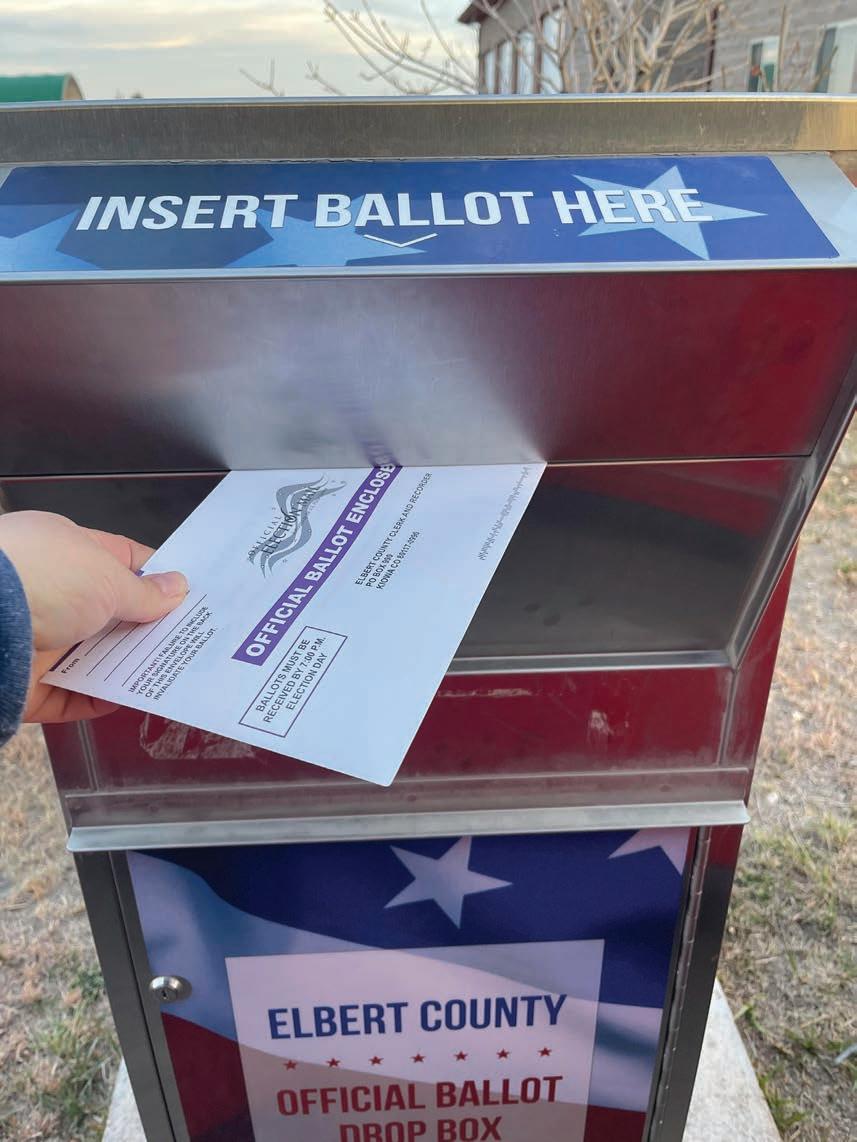
6 minute read
Metro Denver median home prices finally dropped
After 2 years of growth
BY TAMARA CHUANG THE COLORADO SUN

For the rst time in recent memory, the median price of a house in metro Denver is less than it was a year ago.
And for some who make a living selling houses, there’s a sense of relief.
“Every single month in 2021 and the rst half of 2022, everybody in our (real estate) community went, ‘Oh my goodness. How much more can this go? What will buyers put up with?’ I mean having to pay a penny over the appraised value is just bonkers to me,” said Matt Leprino, CEO of Denver-based real estate brokerage Remingo.
Now, he said, “It’s calm, it’s a very tepid pool right now. It’s not increasing. It’s not going crazy. Days on market are up. But they’re up from historic lows. e majority of phone calls we get right now are … ‘Can I jump in right now?’”


New data for January from the Colorado Association of Realtors has median home prices attening statewide. Houses are taking twice as long — sometimes three times longer — to sell compared to a year ago. But that’s not very long. In the seven-county metro Denver area, that’s 53 days, or about four weeks longer than 22 days in January 2022. at’s getting back to the time just before the pandemic, or 48 days in
January 2020.
Home prices in Denver and Colorado increased at unprecedented rates in the past two years. Metro Denver’s median sales price hit a high of $660,000 in April, up 17.4% in a year. at dropped to $569,804, as of January, which is 1.4% lower than a year-ago January. As Littleton economist Patty Silverstein told the real estate industry at an economic summit last week, “We’re (in) some type of slowdown but that’s very welcome. We’re in a rest period here.” e slowdown began last spring as the Federal Reserve raised interest rates to cool in ation. But mortgage rates have more than doubled in a year, making it much more expensive for home buyers who need a loan. Based on the Denver metro area’s median sales price, a buyer’s monthly payment is roughly $1,000 more than it would have been last January, according to Bankrate’s mortgage calculator.
“ e major thing we have seen is a dramatic slowdown in activity,” said Ann Hayes, a Realtor with Keller Williams Colorado West Realty in Grand Junction. “A lot of people, with the change in the interest rates, were priced out of the market.”


Mesa County saw a 3.4% dip in its median-sales price, falling to $379,950 in January. at makes it a little more a ordable for rst-time buyers. But even though mortgage rates are below their peak, they are still above 6.5%. And that’s keeping homeowners in their homes, too.
“Sellers don’t like the fact that they’re at a 3% (mortgage loan) rate and if they buy a replacement, they’re going to be at six, or six and three-quarter rate,” Hayes said. “A lot of sellers are not even coming on the market.”
Some perspective
But the past two years have just been unprecedented, said Hayes, who’s sold houses in the area since 1994. Fifteen years ago, mortgage rates were in the 6% to 7% range, and back in the 1980s, they were double digits, with 30-year xed rate loans averaging 18.63% in 1981, according to Freddie Mac historical data.
Still, Mesa County is a relatively hot market. e number of houses for sale in the area in and around Grand Junction has doubled in the past year to 456, compared with inventory of 1,816 homes in 2016, according to CAR. Over time, she said, buyers adjust to higher rates and higher prices if that’s where the market goes.

“People will have more babies
1-877-328-1512




(and) that will encourage people to think about doing other things,” Hayes said. “Life will start happening where it’s, ‘Well, I don’t like the interest rate, but, you know, a twobedroom house with four kids isn’t going to work anymore.’”
Ask anyone in the real estate industry and they’ll tell you buying a house is a long-term investment. Values go up overtime even after slumps during downturns.
“At no time in recorded history have prices, generally speaking, decreased,” said Leprino, pointing to the price dips of 2008, the early 1990s and other recessions. For the most part, the price of a house today is much higher than it’s ever been.
Higher prices, multiple o ers still exist
But every market is di erent. Places like Pagosa Springs are dealing with a scarcity of houses below their median sales price, which increased a whopping 33% to $520,000 in January. Local Realtor Wen Saunders said the lower-priced homes below the $400,000 range “were gobbled up with low interest rates and cash buyers,” and many who were buying a second home.
“ e bread and butter for Pagosa was always somewhere in the $300,000s. at was a beautiful thing. In 2021, we sold 105 and in 2022, we sold 56. Why? Because we didn’t have any more,” said Saunders, who’s been a Realtor in Pagosa for 14 years.
Meanwhile, the million-dollar homes went the other direction. Back in 2017, she said Pagosa had a ve-year inventory of million-dollar homes and only about ve sold in a year.
“In 2021, we sold 48 homes that were in the million-dollar price point. And then there were another 11 that were in the $2 million range,” she said. “ e number of sales will drop, but I just don’t see the prices dropping.” e data from the Northern Colorado multiple listing service recorded the city’s median price in January at $549,999, up about $11,000 from a year ago. In Larimer County, median sale prices increased 6.4% to $570,000, according to CAR data. Inventory has nearly doubled in a year, but it’s only taking two weeks longer to get a house sold in the county.
In Fort Collins, the median sales price in January was also higher than a year ago. ere are still multiple o ers going on, said Chris Hardy at Elevations Real Estate in Old Town Fort Collins. For one of his fellow agents, 8 out of 10 sales in January involved multiple o ers.
“It wasn’t like it was back in April or May when there were 15, 20 and 30 o ers on any home that came on the market. But there were at least two or more o ers on these homes,” Hardy said.
But Hardy added a caveat to the higher prices. Houses aren’t necessarily getting their full list price, especially those on the market since November. ose have likely reduced their price. And competition among buyers doesn’t mean houses are selling above the asking price.
“Last summer, you couldn’t buy anything inside the city limits of Fort
Collins for under $500,000,” Hardy said. “ ere wasn’t anything and now that’s changed a little bit and so there are some homes in the midfours that get snapped up relatively quickly. In those highly desirable price points, there’s still quite a bit of activity.”
A busier spring?
Since the fourth quarter, the number of people hoping to get pre-quali ed for a mortgage has increased 50%-60%, said Shawn Ostho , president of Bank of Colorado, which has branches all over the state and is headquartered in Fort Collins. ere are seasonal reasons for the uptick in this quarter and the overall number of loans is still lower than a year ago.
“I think many people have come to the realization that we’re at kind of a new normal for mortgage rates and therefore they’re choosing to proceed with a home,” Ostho said. “We’ll see how strong the demand is this spring, but historically springtime has been a time when people are out looking for a new home and upgrading their house. We expect more activity this spring than we’ve seen in the last six months.”
Prospective buyers are not just gearing up to hunt for a house again; more seem to be opting for a different type of mortgage, an adjustable-rate mortgage. ARMs at Bank of Colorado o er a lower interest rate of 5.875% in the rst ve years. Borrowers can re nance anytime if rates drop. Comparably, the bank’s 30-year rate is 6.375%, which includes 1% in mortgage points to reduce the interest over the life of the loan.
“Just trying to save a little bit of interest with the hope that rates might come back down, that’s the thinking here,” he said. “It gives them a chance to buy a home they can a ord.” e Fed-regulated interest rates are expected to decline since in ation is slowing. On Tuesday, the Consumer Price Index for January showed that it cost U.S. households 6.4% more to live, compared to a year ago. at was a smidge lower 6.5% in December and down from 9% in summer. e Fed has already backed o the higher rate increases, dropping to a quarter point hike on Feb. 1 from the several months of three-quarter point increases. is, of course, means in ation and interest rates are still rising. But Silverstein, president of Development Research Partners in Littleton, believes consumers are already getting used to it.
“Consumers will start to adapt, will start to expect those slightly higher interest rates given that we still have people moving into this state,” Silverstein said. “We still have a lot of folks that have put o housing purchases (and saying) ‘OK, a 5% to 6% mortgage rate is not outrageous. We just need to take it into consideration as we’re planning for future purchases.’ Consumers are still out there.” is story is from e Colorado Sun, a journalist-owned news outlet based in Denver and covering the state. For more, and to support e Colorado Sun, visit coloradosun.com. e Colorado Sun is a partner in the Colorado News Conservancy, owner of Colorado Community Media.









